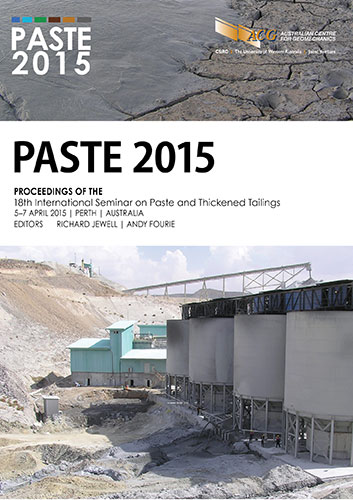Managing high-density tailings disposal – deposition, water management and closure considerations

|
Authors: Kam, S; Yaschyshyn, D; Hmidi, N |
DOI https://doi.org/10.36487/ACG_rep/1504_42_Kam
Cite As:
Kam, S, Yaschyshyn, D & Hmidi, N 2015, 'Managing high-density tailings disposal – deposition, water management and closure considerations', in R Jewell & AB Fourie (eds), Paste 2015: Proceedings of the 18th International Seminar on Paste and Thickened Tailings, Australian Centre for Geomechanics, Perth, pp. 547-559, https://doi.org/10.36487/ACG_rep/1504_42_Kam
Abstract:
There has been a growing interest in the surface disposal of high-density tailings in recent years. Such an interest is driven primarily by the need to conduct mining in a sustainable manner by minimising environmental and social impact, conserving water and improving tailings safety. Increasingly, more mines are considering thickened or paste tailings disposal in conjunction with paste tailings backfill to better utilise their infrastructure. Several factors have hindered the wider adoption of high-density surface tailings disposal technology. The ability to predict tailings behaviour in full scale is still relatively limited. There is also little experience in managing a high-density tailings facility under varied climatic conditions. A number of high capacity mines have also had production issues meeting the tailings consistency criterion for deposition leading to major reconfiguration of the disposal system due to poor field performance. Some of these uncertainties are being addressed through laboratory and field research with significant advances being made on our understanding on tailings rheology, transportation, mechanism of deposition and post deposition behaviour change of the tailings. High-density tailings facilities will require a greater degree of management than conventional slurry tailings. Not only are the tailings likely more variable, there are unique challenges associated with tailings deposition and water management. This paper discusses tailings deposition control and water management methods that have been successfully used at a number of high-density tailings facilities with special reference made to central cone deposition in the Kidd Metallurgical Site and perimeter deposition at the Musselwhite Mine. Both of these facilities are located in cold climatic regions in Canada with surplus precipitation. Contingency measures that have been adopted to reduce the risk of system upsets and non-performance, and closure considerations for these facilities are highlighted. Field experience has shown that high-density tailings disposal can offer unique opportunities for progressive rehabilitation and optimisation of the closure design.
References:
Caldwell, J, Revington, A, McPhail, G & Charlebois, L 2014, ‘Optimised seasonal deposition for successful management of treated mature fine tailings’, in R Jewell, A Fourie, PS Wells & D. van Zyl (eds), Proceedings of the 17th International Seminar on Paste and Thickened Tailings, Australian Centre for Geomechanics, Perth, pp. 371-379.
Fitton, TG 2014, ‘The accuracy of tailings beach slope predictions’, in RJ Jewell, AB Fourie, PS Wells & D van Zyl (eds), Proceedings of the 17th International Seminar on Paste and Thickened Tailings, Australian Centre for Geomechanics, Perth, pp. 47-58.
Habte, K, Merry, P, Welch, D & Chouinard, L 2014, ‘Design and performance of a water collection dam with permafrost seepage barrier, Nunavik Nickel Mine, Quebec’, Proceedings of the Canadian Dam Association Annual Conference.
Kam, S, Hmidi, N & Mao, Y 2014, ‘Field performance of thickened tailings disposal at Musselwhite Mine’, in RJ Jewell, AB Fourie, PS Wells & D van Zyl (eds), Proceedings of the 17th International Seminar on Paste and Thickened Tailings, Australian Centre for Geomechanics, Perth, pp. 627-639.
Kam, S, Yaschyshyn, D, Scott, D & Patterson, M 2009, ‘Thickened tailings disposal at Xstrata Copper Kidd Metallurgical Site’, Proceedings of the 8th International Conference on Acid Rock Drainage, American Society of Mining and Reclamation, Champaign.
Lopes, R, Bahia, R, Jefferies, M & Oliveira, M 2013, ‘Paste deposition over an existing subaqueous slurry deposit of high sulphide content tailings – the Neves Corvo experience’, in RJ Jewell, AB Fourie, J Caldwell & J Pimenta (eds), Proceedings of the 16th International Seminar on Paste and Thickened Tailings, Australian Centre for Geomechanics, Perth, pp. 21-35.
Raposo, N, Bahia, R, Afonso, E & Topa Gommes, A 2014, ‘Optimisation of thickened tailings deposition’, in RJ Jewell, AB Fourie, P Wells & D van Zyl (eds), Proceedings of the 17th International Seminar on Paste and Thickened Tailings, Australian Centre for Geomechanics, Perth, p. 651.
Theron, M, Addis, P, Wates, J & Vincent, M 2005, ‘Buyanhulu Mine paste tailings facility, relating the unsaturated properties of gold tailings to rate of rise’, in RJ Jewell & S Barrera (eds), Proceedings of the 8th International Seminar on Paste and Thickened Tailings, Australian Centre for Geomechanics, Perth, pp. 219-230.
Wates, JA, Venter, H, O’Callaghan, A & Tucker, J 2014, ‘The influence of feed properties on cyclone performance and stacking of underflow’, in RJ Jewell, AB Fourie, PS Wells & D van Zyl (eds), Proceedings of the 17th International Seminar on Paste and Thickened Tailings, Australian Centre for Geomechanics, Perth, pp. 445-458.
Williams, MPA, Seddon, KD & Fitton, TG 2008, ‘Surface disposal of paste and thickened tailings – a brief history and current confronting issues’, in AB Fourie, RJ Jewell, PT Slatter and A Paterson (eds), Proceedings of the 11th International Seminar on Paste and Thickened Tailings, Australian Centre for Geomechanics, Perth, pp. 143-164.
Yuan, XS & Lahaie, R 2010, ‘Paste and thickened tailings technology and its application in oil sand tailings management’, in RJ Jewell & AB Fourie (eds), Proceedings of the 13th International Seminar on Paste and Thickened Tailings, Australian Centre for Geomechanics, Perth, pp. 437-449.
© Copyright 2024, Australian Centre for Geomechanics (ACG), The University of Western Australia. All rights reserved.
View copyright/legal information
Please direct any queries or error reports to repository-acg@uwa.edu.au
View copyright/legal information
Please direct any queries or error reports to repository-acg@uwa.edu.au